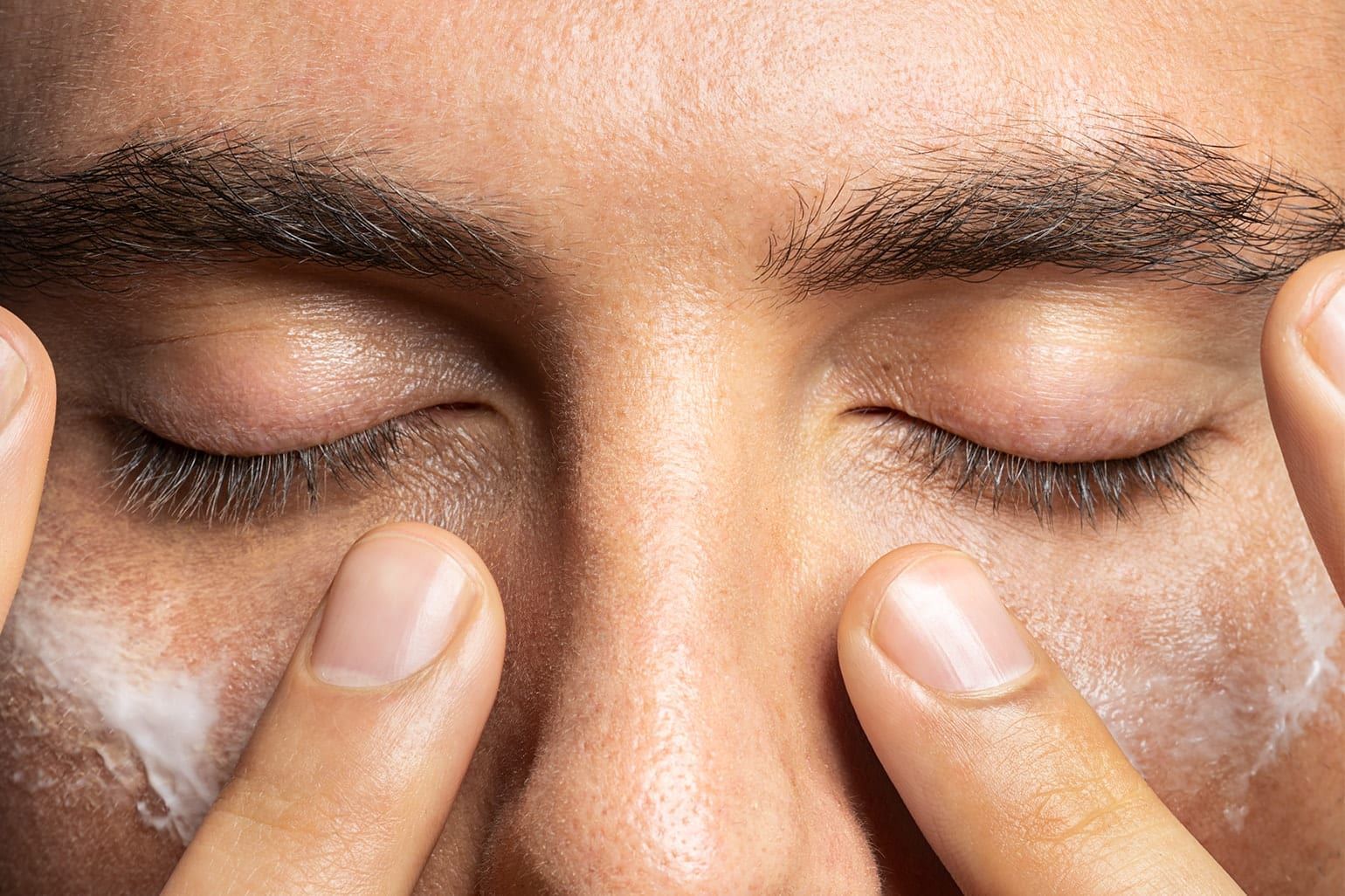
Rosacea and Men: Understanding the Unique Challenges and Treatment Options
This article delves into the unique challenges faced by men with rosacea. Discover how to improve your skin health and quality of life with expert insights and advice.
By SunsolveMD Team | 8 Min. Read
May 2, 2023If you are looking for advice on rosacea, most likely, you'll find a myriad of sources online discussing this frequent skin condition for women audience. Although clinical studies have suggested that rosacea may occur up to three times more frequently in women than men, the unique way it affects men shouldn't be overlooked.
Rosacea is a chronic skin condition that mainly affects the face—think rosy cheeks, chin, and nose. Or if you have a darker skin tone, the flare-ups appear more violet and less pink. Rosacea may also appear as pimples and bumps or even visible blood vessels. According to the National Rosacea Society, problems with the immune system and inflammation are the leading causes of rosacea.
While there is currently no cure for rosacea, there are effective treatments you should consult with your dermatologist. The most common treatment methods are topical or oral prescription medications, creams, lasers, and light therapy.
How rosacea affects men differently
Although it varies from person to person, rosacea symptoms are usually more pronounced in men and characterized by increased redness and flushing. In addition to redness, men are more likely to experience thickened skin and visible blood vessels, particularly on the nose.
According to one study published in the Journal of the American Academy of Dermatology men have a higher risk of developing a severe form of rosacea known rhinophyma, a condition in which increased inflammation leads to swollen and bumpy nose. The study also found that men were more likely to experience ocular rosacea, which affects the eyes and can cause redness, dryness, and irritation.
Another study published in the Journal of Dermatology suggests that genetics may play a stronger role in the development of rosacea in men. Men may not feel comfortable speaking up about issues like rosacea and seeking help, and this is due to a complex interplay of different factors.
Daniel Bach, M.D, a dermatologist at UCLA Medical Center in Los Angeles, confirms that 'men tend to tolerate rosacea a little more, so often go undiagnosed or untreated, whether that is more societal or just nature of the disease. Many just live with the symptoms."
The signs & symptoms of rhinophyma
In the past, doctors used to think that rhinophyma was the result of drinking too much alcohol, but that's not the case. It most likely affects white men over 50, and this is due to men having significantly more glands in the face and especially with the nose. Although we don't know the exact cause, it is likely to result from multiple factors, including genetics, environmental triggers, and microorganisms in the body. If you spot redness, enlarged pores, and a bulbous nose, those may be the classic signs of rhinophyma. It's best to intervene as soon as possible to prevent the skin from thickening, disfiguring the nose, and leading to unwanted facial changes over time.
The first step to reduce inflammation is to use oral or topical antibiotics. If these first lines don't set you on the right path, other options like laser or plastic surgery are available. In more severe cases where too much excess skin has formed over the nose, plastic surgery may be the only viable solution. According to the Beverly Hills Center for Plastic surgery, there are various ways to treat rhinophyma, including scalpel, laser, electrosurgery, and dermabrasion. They are all designed to remove (or shave off) the excess thick sebaceous skin and restore a normal contour and texture. If you want a procedure to eliminate the bumps, swelling, redness, and excess tissue on your nose, you should consider rhinophyma plastic surgery. It is important to note that plastic surgery cannot cure rhinophyma or rosacea that causes it.The number of laser treatments and how often they are needed varies from person to person. Rosacea is one of the most common skin conditions, and while none of these treatments are a cure, it's important to be proactive and stay on top of your condition. Don't delay seeing a dermatologist so you can benefit from an accurate diagnosis and discuss the various preventative measures to minimize flares early on.
Rosacea Skincare tips
Scroll down for some skincare dos and don'ts to keep your rosacea in check and prevent flare-ups. Yes, skincare routines are for all genders! From combating redness to easing pain and discomfort, here are the basics.
Use gentle products
More pain isn't always more gain, so try to avoid using harsh products, thinking they work better for the skin. They can have the opposite effect. National Rosacea Society recommends cleaning your face with a mild and non-abrasive facial cleanser. Rinse with lukewarm water and gently dry your face with a cotton towel.
Know your label
There is no need to geek into a science-level understanding of each ingredient in skincare products. The best way is to test the product on a small batch of the skin. Whenever possible, ask for a tester. Pay attention to ingredients like fragrance, alcohol, menthol, witch hazel, peppermint, and eucalyptus oil that may aggravate your skin, says the National Rosacea Society.
Apply sunscreen daily
Although sun exposure is the top trigger for 81% of people with rosacea, men are much less likely to use sunscreen. Still, luckily there are many innovative technologies and formats today that are easier to apply. The National Rosacea Society recommends broad-spectrum mineral-based sunscreens that protect against UVA and UVB rays with an SPF of at least 30. Make sure to choose a product specially formulated for sensitive skin and apply it regularly throughout the year, not just during the beach season.
What about shaving?
To avoid aggravating marks, it is important to use a sharp, clean razor blade and to shave in the direction of hair growth. It helps to minimize irritation and prevents ingrown hairs, which can aggravate rosacea symptoms. The trick is to use a light touch and avoid applying too much pressure, which can cause redness and irritation.
Your alcohol intake
While it changes from person to person, drinking alcohol may trigger flare-ups in some men.
Potential trigger foods
Even if the sweet stuff looks completely harmless, and just like spicy foods it can trigger flushing. Since triggers can vary from individual to individual, it's worth paying attention to see if it's a trigger for you.
Don't let stress take over
It shouldn't come as a surprise that stress is as bad for your rosacea as it is for you. Try to take steps to reduce stress in your life by regularly exercising, practicing relaxation techniques, and getting enough sleep.
Probiotics for skin
Did you know the fact that bacterial cells are already present in your body? The difference with rosacea sufferers is the way their body react to the presence of those living microorganisms. Registering them as a potential threat, the body prepares a counteraction, resulting in inflammation, redness, bumpiness, and more. Research suggests a potential relationship between rosacea and Helicobacter pylori, a pathogenic bacteria found in the stomach and small intestine. One study shows that those with rosacea have a significantly higher number of H.pylori bacteria. Probiotics are there to maintain the equilibrium between good and bad bacteria. You may want to choose between two different types: topical and oral probiotics.
Topical probiotics
Topical probiotics are a growing trend in skincare. They use good bacteria to strengthen your skin's natural protective mechanisms and send health signals to your skin cells. Although topical probiotics offer a promising new area of skincare research, it is important to consult a dermatologist or skincare professional before incorporating these products into your skincare routine.
Oral probiotics
Your body is full of trillions of bacteria, viruses, and fungi. These active microorganisms, collectively known as microbiome, help us stay happy and healthy. The role of probiotic supplementation in treating dermatological conditions has been studied for many years. Recent studies show promising results that support the correlation between gut health and immunity. So, yes, probiotics also work from the inside out! The studies show us that oral probiotics can decrease skin sensitivity and increase the rate of barrier function recovery. If you plan to supplement probiotics, look for products backed by research or solid and authentic reviews. Consumption of probiotic foods is also a great way to ensure you're maintaining a healthy gut microbiome. Try to include a portion of the following foods daily: sauerkraut, kimchi, kefir, miso, tempeh, kombucha, or even natural live yogurt. Though experts agree that further research is needed to fully prove the benefits of probiotics for those suffering from common skin conditions, it is a well-established and exciting field of research.
References
1. Stats on Rhinophyma Study: Facial Plastic Surgery. (2012). “Nuances in the management of rhinophyma.” pubmed.ncbi.nlm.nih.gov/22562574/
2. Rosacea Sunscreen Tips: Sunscreen for Rosacea. (2019). The National Rosacea Society. rosacea.org/patients/skin-care/sunscreen-for-rosacea
3. Rosacea Triggers: Skin Care, Trigger Management Can Help Control Rosacea. (2020). The American Academy of Dermatology. aad.org/public/diseases/rosacea/triggers
4. Gravina, AG. Federico, A. Romano, M. (2015). ‘Helicobacter pylori infection but not small intestinal bacterial overgrowth may play a role in rosacea’,United European Gastroenterology Journal, 3 (1), pp.17-24. [Online]. Available at: https://www.ncbi.nlm.nih.gov/pmc/articles/PMC4315682/
